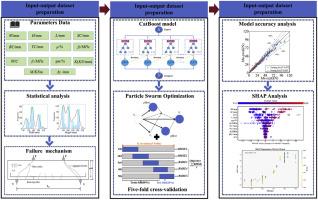一个具有解释性的元启发式驱动的分类增强框架,用于腐蚀钢筋混凝土梁的力学性能的高精度预测
IF 8
2区 计算机科学
Q1 AUTOMATION & CONTROL SYSTEMS
Engineering Applications of Artificial Intelligence
Pub Date : 2025-10-21
DOI:10.1016/j.engappai.2025.112804
引用次数: 0
摘要
腐蚀钢筋混凝土(RC)梁的力学性能退化是评估结构耐久性的主要挑战。为了解决这个问题,本研究提出了一个集成的机器学习(ML)框架来预测此类梁的力学性能。首先,建立464个样本的数据库,包括12个输入参数和2个输出参数,然后对输入进行相关性分析。在此基础上,对现有设计规范和经验模型的适用性进行了评价。随后,对8个ML模型进行训练,并通过贝叶斯优化(BO)对其超参数进行优化,以提高预测精度。在此基础上,利用粒子群算法(PSO)和遗传算法(GA)对CatBoost模型的超参数进行了进一步优化,提高了模型的性能。结果表明,pso优化后的CatBoost模型具有最高的预测精度:对于抗弯强度测试集,决定系数(R2)为0.984,均方根误差(RMSE)为3.1602;挠度测试集R2为0.975,RMSE为0.6259。与设计规范相比,抗弯强度试验集R2提高27.3%,RMSE降低72.8%;与支持向量回归(SVR)等传统模型相比,R2上升5.4%,RMSE下降43.5%。此外,SHapley加性解释(SHAP)分析显示,几何参数(梁高、梁宽)主导抗弯强度,而弹性刚度和梁长驱动挠度。最后,开发了用于腐蚀钢筋混凝土梁力学性能快速评估的图形用户界面(GUI)。本文章由计算机程序翻译,如有差异,请以英文原文为准。

A metaheuristic-driven categorical boosting framework with interpretability for high-precision prediction of mechanical properties in corroded reinforced concrete beams
The degradation of mechanical properties in corroded reinforced concrete (RC) beams presents a major challenge for assessing structural durability. To address this issue, this study proposes an integrated machine learning (ML) framework to predict the mechanical properties of such beams. First, a database of 464 samples was established, including 12 input parameters and 2 output parameters, followed by correlation analysis of the inputs. On this basis, the applicability of existing design codes and empirical models was evaluated. Subsequently, eight ML models were trained, with their hyperparameters optimized via Bayesian optimization (BO) to enhance prediction accuracy. The Categorical Boosting (CatBoost) model was identified as the most accurate, and its hyperparameters were further optimized using Particle Swarm Optimization (PSO) and Genetic Algorithm (GA) for improved performance. Results show the PSO-optimized CatBoost model achieves the highest prediction accuracy to date: for the flexural strength test set, the coefficient of determination (R2) is 0.984 and root mean square error (RMSE) is 3.1602; for the deflection test set, R2 is 0.975 and RMSE is 0.6259. Compared with design codes, flexural strength test set R2 increases by 27.3 % and RMSE decreases by 72.8 %; versus traditional models like Support Vector Regression (SVR), R2 rises by 5.4 % and RMSE drops by 43.5 %. Additionally, SHapley Additive exPlanations (SHAP) analysis reveals geometric parameters (beam height, beam width) dominate flexural strength, while elastic stiffness and beam length drive deflection. Finally, a user-friendly graphical user interface (GUI) was developed for rapid mechanical property assessment of corroded RC beams.
求助全文
通过发布文献求助,成功后即可免费获取论文全文。
去求助
来源期刊

Engineering Applications of Artificial Intelligence
工程技术-工程:电子与电气
CiteScore
9.60
自引率
10.00%
发文量
505
审稿时长
68 days
期刊介绍:
Artificial Intelligence (AI) is pivotal in driving the fourth industrial revolution, witnessing remarkable advancements across various machine learning methodologies. AI techniques have become indispensable tools for practicing engineers, enabling them to tackle previously insurmountable challenges. Engineering Applications of Artificial Intelligence serves as a global platform for the swift dissemination of research elucidating the practical application of AI methods across all engineering disciplines. Submitted papers are expected to present novel aspects of AI utilized in real-world engineering applications, validated using publicly available datasets to ensure the replicability of research outcomes. Join us in exploring the transformative potential of AI in engineering.
 求助内容:
求助内容: 应助结果提醒方式:
应助结果提醒方式:


